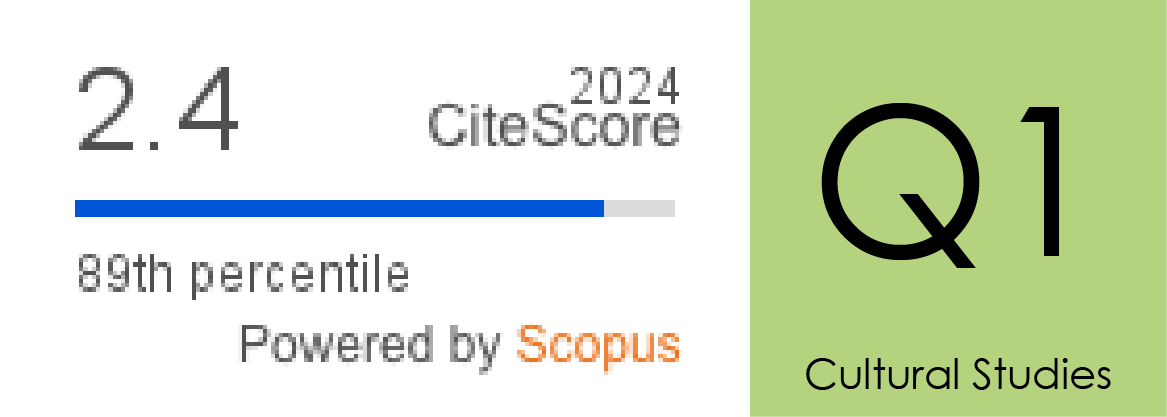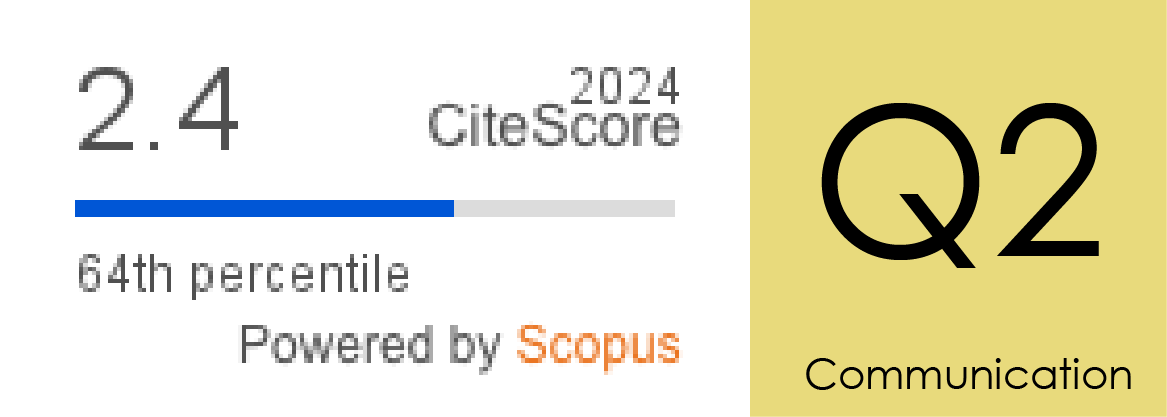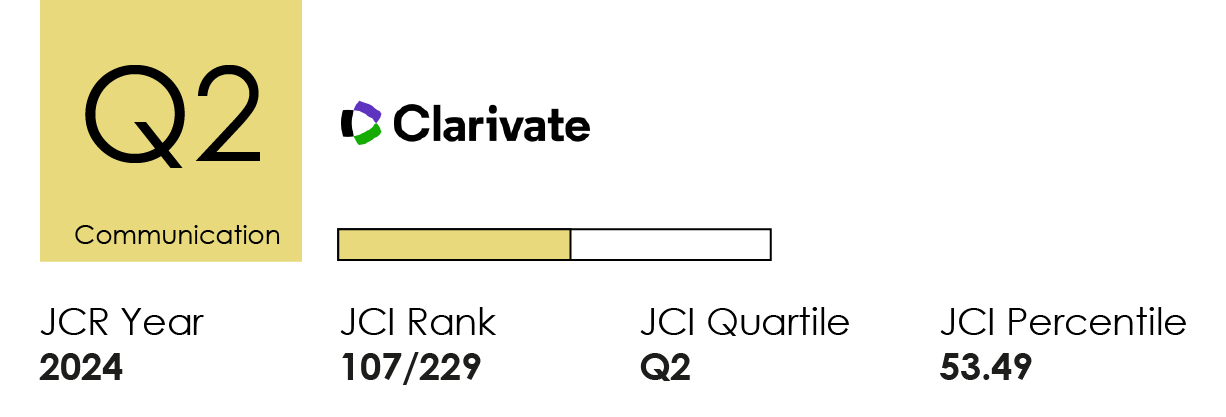Valoración del odio en medios españoles: tipologías, intensidades y escenarios digitales
DOI:
https://doi.org/10.14198/MEDCOM.28666Palabras clave:
Detección, expresiones de odio, medios digitales, medios informativos, monitorieo, redes socialesResumen
Propósito. Este estudio analiza la percepción de los actores de la comunicación, el sector social y la academia sobre la presencia y difusión del discurso de odio en los medios informativos digitales en España, con el fin de identificar discrepancias entre sus percepciones y la realidad mediática. Metodología. Se llevó a cabo una investigación exploratoria a través de una encuesta en línea aplicada a una muestra aleatoria de 199 profesionales de medios, representantes del tercer sector e investigadores académicos. Posteriormente, estos datos fueron contrastados con el análisis de 9.278.137 mensajes recolectados en Facebook, X y portales web institucionales de cinco medios digitales españoles. Resultados y conclusiones. Los hallazgos revelan divergencias entre las percepciones de los agentes encuestados y la realidad de la diseminación del odio en estos medios, especialmente en cuanto a los escenarios de mayor propagación. Se observa una priorización del odio xenófobo sobre otras tipologías y una subestimación del papel del odio político. Además, los encuestados tienden a centrarse en formas extremas de odio, sin considerar aquellas de menor intensidad que pueden contribuir a la normalización de discursos incívicos. Aportación original. Este estudio proporciona una metodología replicable para evaluar la percepción del discurso de odio en medios digitales y contrastarla con datos empíricos, contribuyendo al diseño de estrategias de monitoreo más efectivas y alineadas con la realidad de la comunicación digital.
Financiación
Ministerio de Ciencia e Innovación (Agencia Estatal de Investigación), Universidad Internacional de La RiojaCitas
Bonaut, J., Vicent-Ibáñez, M., & Paz-Rebollo, M. A. (2024). Sports Journalists and Readers: Journalism and User Incivility. Journalism Practice, 18(2), 356–373. https://doi.org/10.1080/17512786.2023.2222730
Brown, A. (2017). What is hate speech? Part 1: The Myth of Hate. Law and Philosophy, 36(4), 419–468. https://doi.org/10.1007/s10982-017-9297-1
Chadwick, A. (2017). The Hybrid Media System: Politics and Power. Oxford University Press. https://doi.org/10.1093/oso/9780190696726.001.0001
Chen, G., & Dang, J. (2022). Crowds’ malice behind the screen: The normative influences of online dehumanization on discrimination against foreigners. Group Processes & Intergroup Relations, 26(7), 1548-1564. https://doi.org/10.1177/13684302221127228
Collins, J. (2023). Mobilising Extremism in Times of Change: Analysing the UK’s Far-Right Online Content During the Pandemic. European Journal on Criminal Policy and Research, 1–23. https://doi.org/10.1007/s10610-023-09547-9
Davies, E., & Dulguerova, E. (2024). Evaluating the performance and influencing factors of three portable black carbon monitors for field measurement. Journal of Environmental Sciences-China, 139, 320–333. https://doi.org/10.1016/j.jes.2023.05.044
De la Peña Sarracén, G. L., & Rosso, P. (2023). Systematic keyword and bias analyses in hate speech detection. Information Processing & Management, 60(5), 103433. https://doi.org/10.1016/j.ipm.2023.103433
Digital News Report (2020). Se debilita la confianza en los medios, resisten las marcas periodísticas y emerge el periodismo local. Digital News Report. https://bit.ly/3Ke7ax1
Dordevic, J. P. (2020). The sociocognitive dimension of hate speech in readers’ comments on Serbian news websites. Discourse Context & Media, 33. https://doi.org/10.1016/j.dcm.2019.100366
Fetscherin, M. (2019). The five types of brand hate: How they affect consumer behavior. Journal of Business Research, 101, 116–127. https://doi.org/10.1016/j.jbusres.2019.04.017
Frenda, S., Ghanem, B., Montes-y-Gómez, M., & Rosso, P. (2019). Online Hate Speech against Women: Automatic Identification of Misogyny and Sexism on Twitter. Journal of Intelligent & Fuzzy Systems, 36(5), 4743–4752. https://doi.org/10.3233/JIFS-179023
Frías-Vázquez, M., & Seoane-Pérez, F. (2019). Hate Speech in Spain Against Aquarius Refugees 2018 in Twitter. In Proceedings of the Seventh International Conference on Technological Ecosystems for Enhancing Multiculturality (pp. 906–910). Asociation for Computing Machinery. https://doi.org/10.1145/3362789.3362849
Gangurde, A., Mankar, P., Chaudhari, D., & Pawar, A. (2022). A Systematic Bibliometric Analysis of Hate Speech Detection on Social Media Sites. Journal of Scientometric, 11(1), 100–111. https://doi.org/10.5530/jscires.11.1.10
García-Baena, D., García-Cumbreras, M. A., Jiménez-Zafra, S. M., García-Díaz, J. A., & Valencia-García, R. (2023). Hope speech detection in Spanish. Language Resources and Evaluation, 57(4), 1487–1514. https://doi.org/10.1007/s10579-023-09638-3
Gómez-García, S., Paz-Rebollo, M. A., y Cabeza-San-Deogracias, J. (2021). Newsgames against hate speech in the refugee crisis. Comunicar: Revista Científica de Comunicación y Educación, 29(67), 123–133. https://doi.org/10.3916/C67-2021-10
Harahap, Y. S., & Siregar, N. (2022). A forensic linguistic approach to interpreting a hate speech case on social media. Vision, 18(1), 58–65. https://doi.org/10.30829/vis.v18i1.1414
Hille, S., & Bakker, P. (2014). Engaging the Social News User. Journalism Practice, 8(5), 563–572. https://doi.org/10.1080/17512786.2014.899758
Jiménez-Amores, J., Blanco-Herrero, D., Sánchez-Holgado, P., y Frías-Vázquez, M. (2021). Detectando el odio ideológico en Twitter. Desarrollo y evaluación de un detector de discurso de odio por ideología política en tuits en español. Cuadernos.Info, (49), 98–124. https://doi.org/10.7764/cdi.49.27817
Jost, P., Maurer, M., & Hassler, J. (2020). Populism Fuels Love and Anger: The Impact of Message Features on Users’ Reactions on Facebook. International Journal of Communication, 14(0), 22. https://ijoc.org/index.php/ijoc/article/view/13400
Kotsakis, R., Vrysis, L., Vryzas, N., Saridou, T., Matsiola, M., Veglis, A., & Dimoulas, C. (2023). A web framework for information aggregation and management of multilingual hate speech. Heliyon, 9(5), e16084. https://doi.org/10.1016/j.heliyon.2023.e16084
Kosterich, A., & Weber, M. S. (2019). Transformation of a Modern Newsroom Workforce. Journalism Practice, 13(4), 431–457. https://doi.org/10.1080/17512786.2018.1497454
Ksiazek, T. B. (2018). Commenting on the News. Journalism Studies, 19(5), 650–673. https://doi.org/10.1080/1461670X.2016.1209977
Lee, R. K.-W. (2023). Predicting hate intensity of twitter conversation threads. Knowledge Based Systems, 275, 110644. https://doi.org/10.1016/j.knosys.2023.110644
Lee, J., Lim, T., Lee, H., Jo, B., Kim, Y., Yoon, H., & Han, S. C. (2022, September 30). K-MHaS: A Multi-label Hate Speech Detection Dataset in Korean Online News Comment. arXiv. https://doi.org/10.48550/arXiv.2208.10684
Liang, H., & Ng, Y. M. M. (2023). The expression effects of uncivil disagreement: The mechanisms of cognitive dissonance and self-perception. Human Communication Research, 49(3), 251–259. https://doi.org/10.1093/hcr/hqac032
Mansur, Z., Omar, N., & Tiun, S. (2023). Twitter Hate Speech Detection: A Systematic Review of Methods, Taxonomy Analysis, Challenges, and Opportunities. IEEE Access, 11, 16226–16249. https://doi.org/10.1109/ACCESS.2023.3239375
Marques, T. (2023). The Expression of Hate in Hate Speech. Journal of Applied Philosophy, 40(5), 769–787. https://doi.org/10.1111/japp.12608
Masullo, G. M., Riedl, M. J., & Huang, Q. E. (2020). Engagement Moderation: What Journalists Should Say to Improve Online Discussions. Journalism Practice, 16(4), 738–754. https://doi.org/10.1080/17512786.2020.1808858
Mourão, R. R., & Brown, D. K. (2022). Black Lives Matter Coverage: How Protest News Frames and Attitudinal Change Affect Social Media Engagement. Digital Journalism, 10(4), 626–646. https://doi.org/10.1080/21670811.2021.1931900
Nascimento, F. R. S., Cavalcanti, G. D. C., & Da Costa-Abreu, M. (2023). Exploring Automatic Hate Speech Detection on Social Media: A Focus on Content-Based Analysis. SAGE Open, 13(2). https://doi.org/10.1177/21582440231181311
Oz, M., Zheng, P., & Masullo Chen, G. (2018). Twitter versus Facebook: Comparing incivility, impoliteness, and deliberative attributes. New Media & Society, 20(9), 3400–3419. https://doi.org/10.1177/1461444817749516
Paasch-Colberg, S., & Strippel, C. (2022). “The Boundaries are Blurry…”: How Comment Moderators in Germany See and Respond to Hate Comments. Journalism Studies, 23(2), 224–244. https://doi.org/10.1080/1461670X.2021.2017793
Paz-Rebollo, M. A., Cáceres-Zapatero, M. D., y Martín-Sánchez, I. (2021). Suscripción a la prensa digital como contención a los discursos de odio. Profesional de La Información, 30(6). https://doi.org/10.3145/EPI.2021.NOV.13
Pérez-Landa, G. I., Loyola-González, O., y Medina-Pérez, M. A. (2021). An Explainable Artificial Intelligence Model for Detecting Xenophobic Tweets. Applied Sciences, 11(22), 10801. https://doi.org/10.3390/app112210801
Perreault, G., Moon, R., Walsh, J., & Perreault, M. F. (2022). “It’s Not Hate but … ”: Marginal Categories in Rural Journalism. Journalism Practice, 0(0), 1–20. https://doi.org/10.1080/17512786.2022.2075782
Plaza-del-Arco, F. M., Molina-González, M. D., Ureña-López, L. A., y Martín-Valdivia, M. T. (2021). Comparing pre-trained language models for Spanish hate speech detection. Expert Systems with Applications, 166, 114120. https://doi.org/10.1016/j.eswa.2020.114120
Poletto, F., Basile, V., Sanguinetti, M., Bosco, C., & Patti, V. (2021). Resources and benchmark corpora for hate speech detection: A systematic review. Language Resources and Evaluation, 55(2), 477–523. https://doi.org/10.1007/s10579-020-09502-8
Prochazka, F., & Obermaier, M. (2022). Trust through Transparency? How Journalistic Reactions to Media-Critical User Comments Affect Quality Perceptions and Behavior Intentions. Digital Journalism, 10(3), 452–472. https://doi.org/10.1080/21670811.2021.2017316
Quandt, T. (2018). Dark Participation. Media and Communication, 6(4), 36–48. https://doi.org/10.17645/mac.v6i4.1519
Reguero-Sanz, I., Berdón-Prieto, P., y Herrero-Izquierdo, J. (2023). Journalism in Democracy: A Discourse Analysis of Twitter Posts on the Ferrerasgate Scandal. Media and Communication, 11(2), 176–187. https://doi.org/10.17645/mac.v11i2.6314
Reimer, J., Häring, M., Loosen, W., Maalej, W., & Merten, L. (2023). Content Analyses of User Comments in Journalism: A Systematic Literature Review Spanning Communication Studies and Computer Science. Digital Journalism, 11(7), 1328–1352. https://doi.org/10.1080/21670811.2021.1882868
Reimer, L. E., Schmitz, C. L., Janke, E. M., Askerov, A., Strahl, B. T., & Matyók, T. G. (2015). Transformative Change: An Introduction to Peace and Conflict Studies. Lexington Books. https://bit.ly/3A3zOz4
Rodríguez, A., Argueta, C., & Chen, Y-L. (2019). Automatic Detection of Hate Speech on Facebook Using Sentiment and Emotion Analysis. In 2019 International Conference on Artificial Intelligence in Information and Communication (ICAIIC) (pp. 169–174). https://doi.org/10.1109/ICAIIC.2019.8669073
Ruiz-Iniesta, A., Blanco Valencia, X., Pérez Palau, D., De Gregorio Vicente, O., Cubillas-Mercado, J. J., Montero-Díaz, J., y Said-Hung, E. (2024). Informe final sobre el scrapeo de datos brutos obtenidos en medios informativos digitales españoles en X, FB y Web. https://doi.org/10.6084/m9.figshare.25187591
Sharipova, H. (2023). Algorithms of Oppression: How Search Engines Reinforce Racism. Leonardo, 56(1), 113–114. https://doi.org/10.1162/leon_r_02331
Statista. (2020). Ranking de las principales marcas de medios de comunicación online según el porcentaje de población que las usaba de forma semanal en España en 2020. Statista. https://bit.ly/3yyhuxo
Sellars, A. (2016, December 1). Defining Hate Speech. Berkman Klein Center Research Publication, (2016-20), 16-48. https://doi.org/10.2139/ssrn.2882244
Suau, J., Masip, P., & Ruiz, C. (2019). Missing the Big Wave: Citizens’ Discourses Against the Participatory Formats Adopted by News Media. Journalism Practice, 13(10), 1316–1332. https://doi.org/10.1080/17512786.2019.1591928
Suau-Jiménez, F., & Ivorra-Pérez, F. M. (2022). Reader Comments Agentive Power in COVID-19 Digital News Articles: Challenging Parascientific Information? Publications, 10(1), 2. https://doi.org/10.3390/publications10010002
Swart, J., Peters, C., & Broersma, M. (2019). Sharing and Discussing News in Private Social Media Groups. Digital Journalism, 7(2), 187–205. https://doi.org/10.1080/21670811.2018.1465351
Tellez, E., Moctezuma, D., Miranda, S., Graff, M., & Ruíz, G. (2023). Regionalized models for Spanish language variations based on Twitter. Language Resources and Evaluation, 57(4), 1697-1727. https://doi.org/10.1007/s10579-023-09640-9
Terren, L., y Borge-Bravo, R. (2021). Echo Chambers on Social Media: A Systematic Review of the Literature. Review of Communication Research, 9. https://rcommunicationr.org/index.php/rcr/article/view/16
Tontodimamma, A., Nissi, E., Sarra, A., & Fontanella, L. (2021). Thirty years of research into hate speech: Topics of interest and their evolution. Scientometrics, 126(1), 157–179. https://doi.org/10.1007/S11192-020-03737-6
Vázquez-Herrero, J., Negreira-Rey, M.-C., y López-García, X. (2023). Misinformation on Trial: Media Coverage of a Murder, Public Conversation and Fact-Checking. Journalism Practice, 1–23. https://doi.org/10.1080/17512786.2022.2164328
Wintterlin, F., Schatto-Eckrodt, T., Frischlich, L., Boberg, S., & Quandt, T. (2020). How to Cope with Dark Participation: Moderation Practices in German Newsrooms. Digital Journalism, 8(7), 904–924. https://doi.org/10.1080/21670811.2020.1797519
Wolfgang, J. D., McConnell, S., & Blackburn, H. (2020). Commenters as a Threat to Journalism? How Comment Moderators Perceive the Role of the Audience. Digital Journalism, 8(7), 925–944. https://doi.org/10.1080/21670811.2020.1802319
Descargas
Estadísticas
Publicado
Cómo citar
Número
Sección
Licencia
Derechos de autor 2025 Julio Montero-Díaz, Elias Said-Hung, Alicia Moreno-Delgado

Esta obra está bajo una licencia internacional Creative Commons Atribución 4.0.
Los autores y autoras que publican en esta revista están de acuerdo con los siguientes términos:
1 Derechos de autor. Los autores y autoras conservan sus derechos de autor, aunque ceden a la revista de forma no exclusiva los derechos de explotación (reproducción, distribución, comunicación pública y transformación) y garantizan a esta el derecho de primera publicación de su trabajo, el cual estará simultáneamente sujeto a la licencia indicada en punto 2. Los autores pueden establecer otros acuerdos adicionales para la distribución no exclusiva de la versión de la obra publicada en la revista, siempre que exista un reconocimiento de su publicación inicial en esta revista.
© Los autores.
2 Licencia. Los trabajos se publican en la revista sujetos a la licencia de Reconocimiento 4.0 Internacional de Creative Commons (CC BY 4.0); los términos se pueden consultar en https://creativecommons.org/licenses/by/4.0/
Esta licencia permite a terceros compartir (copiar y redistribuir el material en cualquier medio o formato) y adaptar (remezclar, transformar y crear a partir del material para cualquier finalidad, incluso comercial), siempre que se reconozca la autoría y la primera publicación en esta revista (Revista Mediterránea de Comunicación (RMC) / Mediterranean Journal of Communication (MJC), Universidad de Alicante, DOI de la obra), se proporcione un enlace a la licencia y se indique si se han realizado cambios en la obra.
3 Política de autoarchivo. Se recomienda a los autores que difundan sus trabajos a través de Internet para favorecer una circulación y difusión más rápidas y, con ello, un posible aumento en la citación y alcance entre la comunidad científica y académica, en las siguientes condiciones:
No se permite a los autores depositar en un repositorio institucional o temático, página web propia, etc., las versiones preprint (versión antes de ser evaluada) o postprint (versión evaluada y aceptada para su publicación) de sus trabajos antes de su publicación, pero sí el artículo final publicado (versión del editor).













